Hassani S. Mathematical Physics: A Modern Introduction to Its Foundations
Подождите немного. Документ загружается.

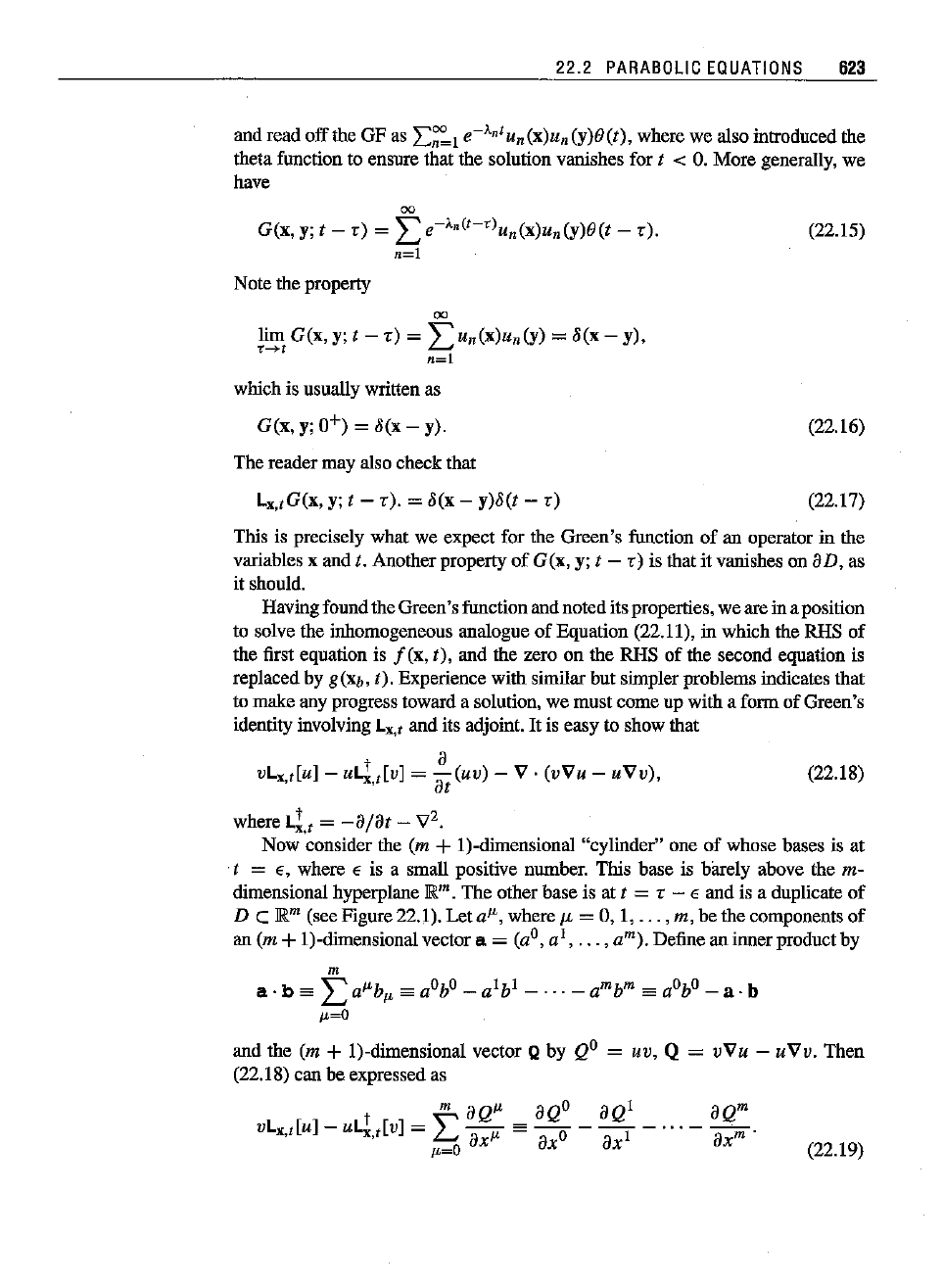
22.2
PARABOLIC
EQUATIONS
623
and read
off
the GF as
L~!
e-J.,IUn(x)Un(y)e(I), where we also introduced the
theta function to ensure that the solution vanishes for I <
O.
More
generally, we
have
00
G(x, y; I -
r)
= L e-J."CI-')Un(x)u
n
(y)e (I -
r).
n=l
Note the property
00
lim
G(x,
y; I -
r)
=
"un(x)un(y)
=
8(x
-
y),
7:-+1
L.."
n=l
which is usually written as
G(x,
y; 0+) =
8(x
- y).
The reader may also check that
LX,IG(X,
y; I -
r).
=
8(x
- y)8(1 -
r)
(22.15)
(22.16)
(22.17)
This is precisely
what
we expect for the
Green's
function
of
an operator in the
variables x and
I.
Another property
of
G(x,
y; I -
r)
is that it vanishes on aD, as
it should.
Havingfoundthe Green'sfunction and notedits properties, we are in a position
to solve the inhomogeneous analogue
of
Equation (22.11), in which the RHS
of
the first equation is f (x, I), and the zero on the
RHS
of
the second equation is
replaced by
g(Xf" I). Experience
with
similar but simplerproblems indicates that
to make any progress toward a solution, we
must
come
up with a form
of
Green's
identity involving
Lx,1
and
its adjoint.
It
is easy to show that
a
vLx,I[U]-
U~,,[V]
= al(uv) - V .
(vVu
-
uVv),
(22.18)
where
LIt
= -a/al - v
2
•
Now
consider the (m +I)-dimensional "cylinder" one
of
whose bases is at
I = E, where E is a small positive nmnber. This base is barely above the m-
dimensional hyperplane
IR
m
.
The other base is at I = r - E and is a duplicate
of
D C IR
m
(see Figure 22.1).
Leta",
where",
= 0, 1,
...
, m, be the components
of
an (m +I)-dimensionalvector a = (ao,
ai,
...
, am). Define an inner product by
m
a·
b es L
a"b"
sa
aObo
-
alb!
-
...
- amb
m
as
aObo
-
a-
b
p,=O
and
the (m + I)-dimensional vector II by
QO
=
UV,
Q =
vVu
-
uVv.
Then
(22.18) can be expressed as
m
aQ"
aQo
aQI
aQm
vLxt[u]
- uL
t
[v]
=
,,--
'"
--
-
--
-
...
-
--.
,
X,I
L..
ax"
ax
o
axl
ax
m
,,~o
(22.19)
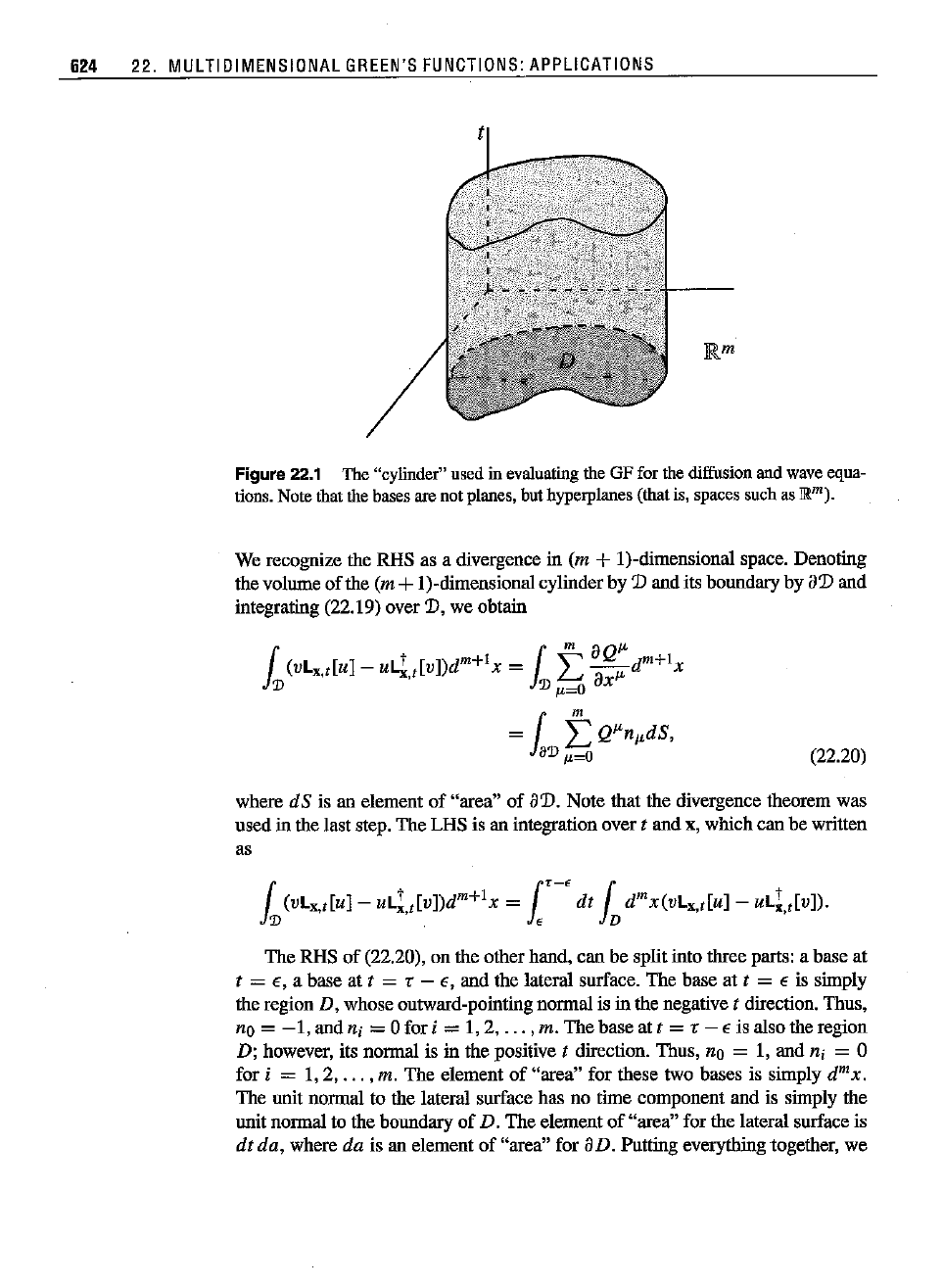
624 22. MULTIDIMENSIDNAL
GREEN'S
FUNCTIDNS:
APPLICATIDNS
Figure22.1 The
"cylinder"
usedin
evaluating
theGFforthediffusion
and
wave
equa-
tions.
Note
that
thebasesarenot
planes,
but
hyperplanes
(thatis,
spaces
suchas
JRrn).
We recognize the RHS as a divergence in (m + I)-dimensional space. Denoting
the volume of the
(m+I)-dimensional cylinder by D and its boundary by a:Dand
integrating (22.19)over D, we obtain
(22.20)
where dS is an element of "area" of a'D. Note that the divergence theorem was
used in the last step. The LHS is an integration over t and x, which can be written
as
The RHS
of
(22.20), on the other hand, can be split into three parts: a base at
t = E, a base at t = 'r - E, and the lateral surface. The base at t = E is simply
the region
D, whose outward-pointing normal is in the negative t direction. Thus,
no =
-1,
andn, = 0for i =
1,2,
...
,m. The base at t = r - E is also the region
D;
however,
its
DOnna!
is in thepositivet
direction.
Thus,
no
= 1,
and
n;
= 0
for i = 1,2,
...
,m. The element
of
"area"
for these two bases is simply dmx.
The unit normal to the lateral surface has no time component and is simply the
unit normal to the boundary
of
D. The element
of
"area" for the lateral surface is
dt da, where da is an element of "area" for
aD.
Putting everything together, we
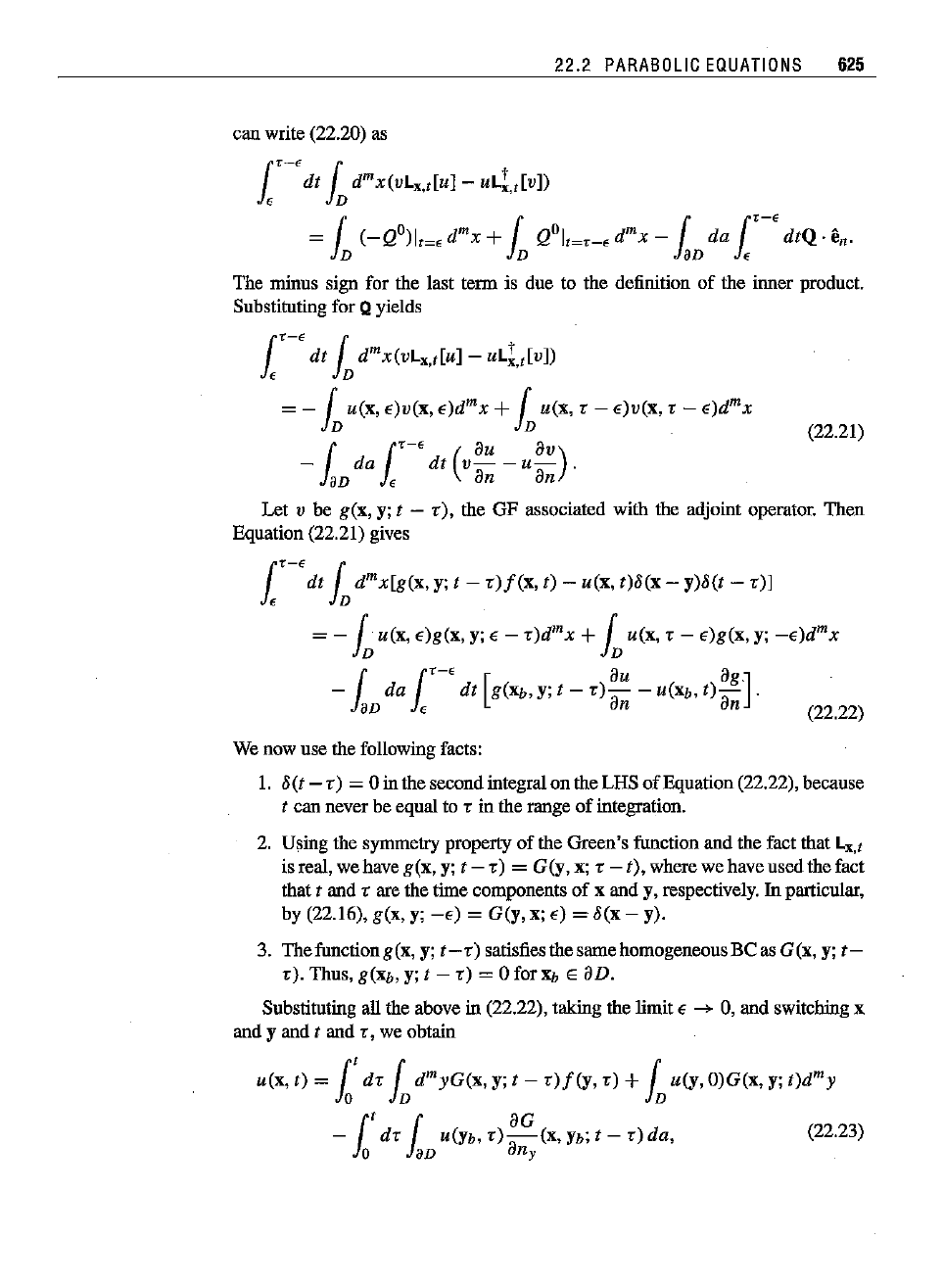
(22.21)
(22.22)
(22.23)
22.2
PARABOLIC
EQUATIONS
625
can write (22.20) as
1'-'
dt
in
dmx(vLx.'[u] - uLI., [v])
=
{(_QO)I,=,dmx+
{
QOI,~,_,dmx-
(
da1'-'dtQ.en.
In In
Jan
e
The minus sign for the last term is due to the definitiou
of
the inner product.
Substituting for
Qyields
1'-'
dt
in
dmx(vLx,,[u] - uLI,,[v])
=
-in
u(x, f)V(X, f)dmx +
in
u(x, r - f)V(X, r - f)dmx
fa
1
,-,
(au
av)
- da dt
v-
-
u-
.
aD,
an an
Let v be g(x, y; t -
r),
the GF associated with the adjoint operator. Theu
Equation (22.21) gives
1'-'
dt
in
dmx[g(x, y; t -
r)f(x,
t) - u(x, t)8(x - y)8(t -
r)]
=
-in
u(x, f)g(X, y; f - r)dmx +
in
u(x, r - f)g(X, y;
-f)dmx
(
1'-'
[ au a
g]
-
laD
da,
dt g(Xb,y; t -
r)
an -
U(Xb,
t)
an
.
We uow use the following facts:
1.
8(t -
r)
= 0 in the second integral on the LHS
of
Equation (22.22), because
t can never be equal to r in the range
of
integration.
2. Using the symmetry property of the Green's function and the fact that
Lx"
isreal, we have g(x, y; t -
r)
= G(y, x; r
-t),
where we have used the fact
that t and r are the time components of x and y, respectively.
In
particular,
by (22.16), g(x, y;
-f)
= G(y, x;
f)
=
8(x
- y).
3. Thefunctiong(x, y;
t-r)
satisfiesthe sarnehomogeneousBC as G(x, y;
t-
r).
Thus, g(Xb,y; t -
r)
= 0 for x, E aD.
Substituting all the above in (22.22), taking the limit f --> 0, and switching x
and y and t and
r,
we obtain
u(x,
t) =
fa'
dr
in
dmyG(x, y; t -
r)f(y,
r)
+
in
u(Y, O)G(x, y; t)dmy
l
'
fa
aG
-
dr
U(Yb,
r)-(x,
Yb;
t -
r)
da,
°
et»
any
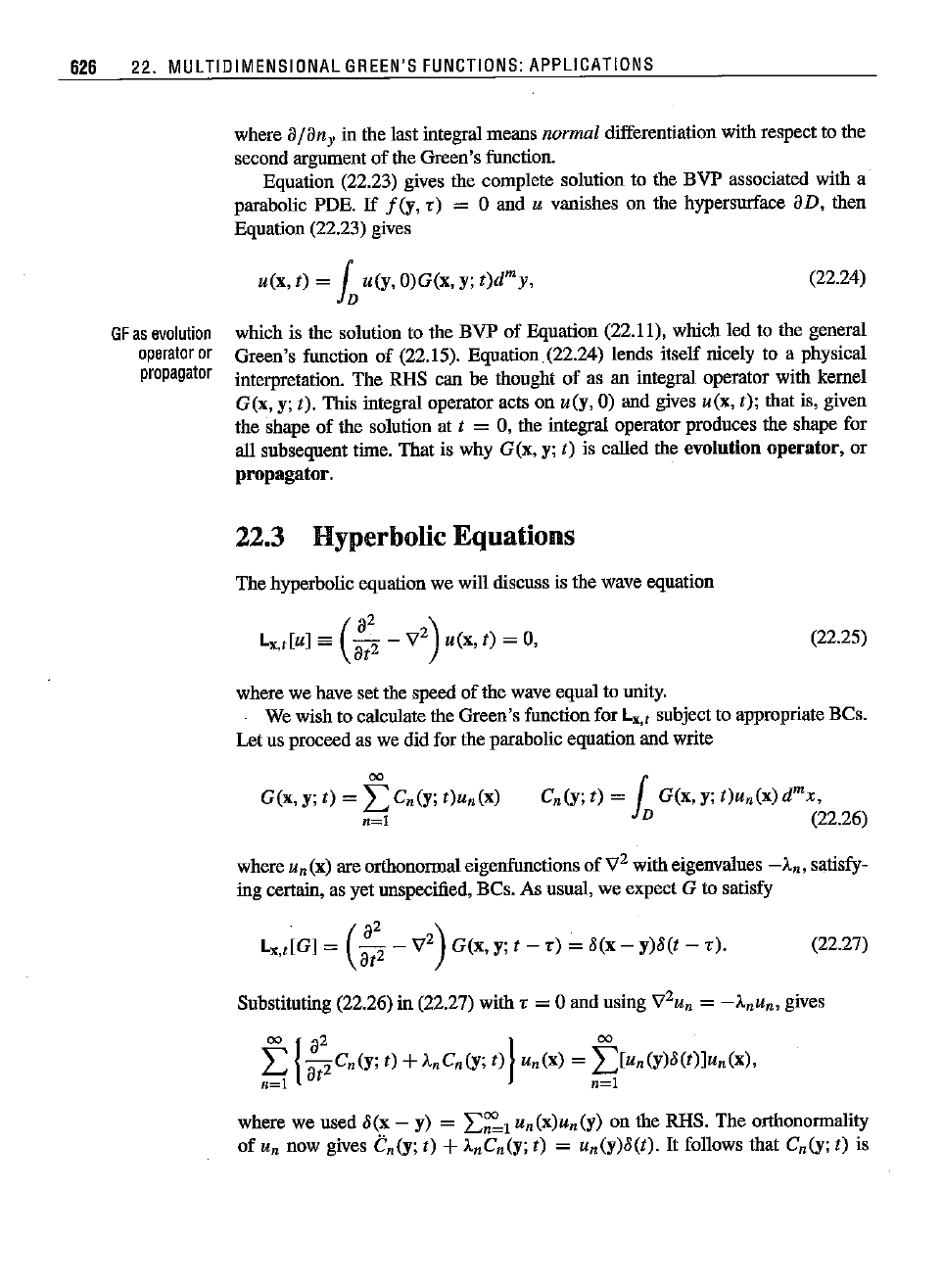
(22.24)
626 22. MULTIDIMENSIONAL
GREEN'S
FUNCTIONS:
APPLICATIONS
where a/any in the last integral means
normal
differentiation with respect to the
second argument
of
the Green's function.
Equation
(22.23) gives the complete solution to the BVP associated with a
parabolic PDE.
If
f
(Y,
r)
= 0 and U vanishes on the hypersurface
aD,
then
Equation
(22.23) gives
u(x,
t) = Lu(y, O)G(x,
Y;
t)dmy,
GF
as
evolution
operator
or
propagator
which is the solution to the BVP of Equation (22.11), which led to the general
Green's function of
(22.15). Equation (22.24) lends itself nicely to a physical
interpretation. The RHS can be thought of as an integral operator with kemel
G(x, y;
t).
This integral operator acts on
u(y,
0) and gives u(x,
t);
that is, given
the shape
of
the solution at t = 0, the integral operator prodnces the shape for
all subsequent time. That is why G(x, y;
t) is called the evolution
operator,
or
propagator.
22.3 Hyperbolic Equations
The hyperbolic equation we will discuss is the wave equation
Lx.t[u]
'"
(::2 -
'1,72)
u(x, t) = 0,
(22.25)
where we have set the speed of the wave equal to unity.
We wish to calculate the Green's function for
Lx,t
subject to appropriate
Bes.
Let us proceed as we did for the parabolic equation and write
00
G(x, y; t) = LCn(y;
t)un(x)
n=l
Cn(y; t) = 1G(x, y;
t)un(x)
dmx,
D (22.26)
where
Un
(x) are orthonormal eigenfunctions
of
'1,72
with eigenvalues
-An,
satisfy-
ing certain, as yet unspecified,
Bes.
As usual, we expect G to satisfy
.
(a
2
)
Lx,t[Gj = at
2
-
'1,72
G(x, y; t -
r)
=8(x -
y)8(t
-
r),
(22.27)
Substituting (22.26) in (22.27) with r =0 and using
'I,72
un
=
-Anu
n,
gives
where we used
8(x
- y) =
L::'1
Un
(x)Un(y) on the RHS. The orthonormality
of
Un
now gives
tn(y;
t) +AnCn(y; t) =
un(y)8(t).
It
follows that Cn(y; t) is
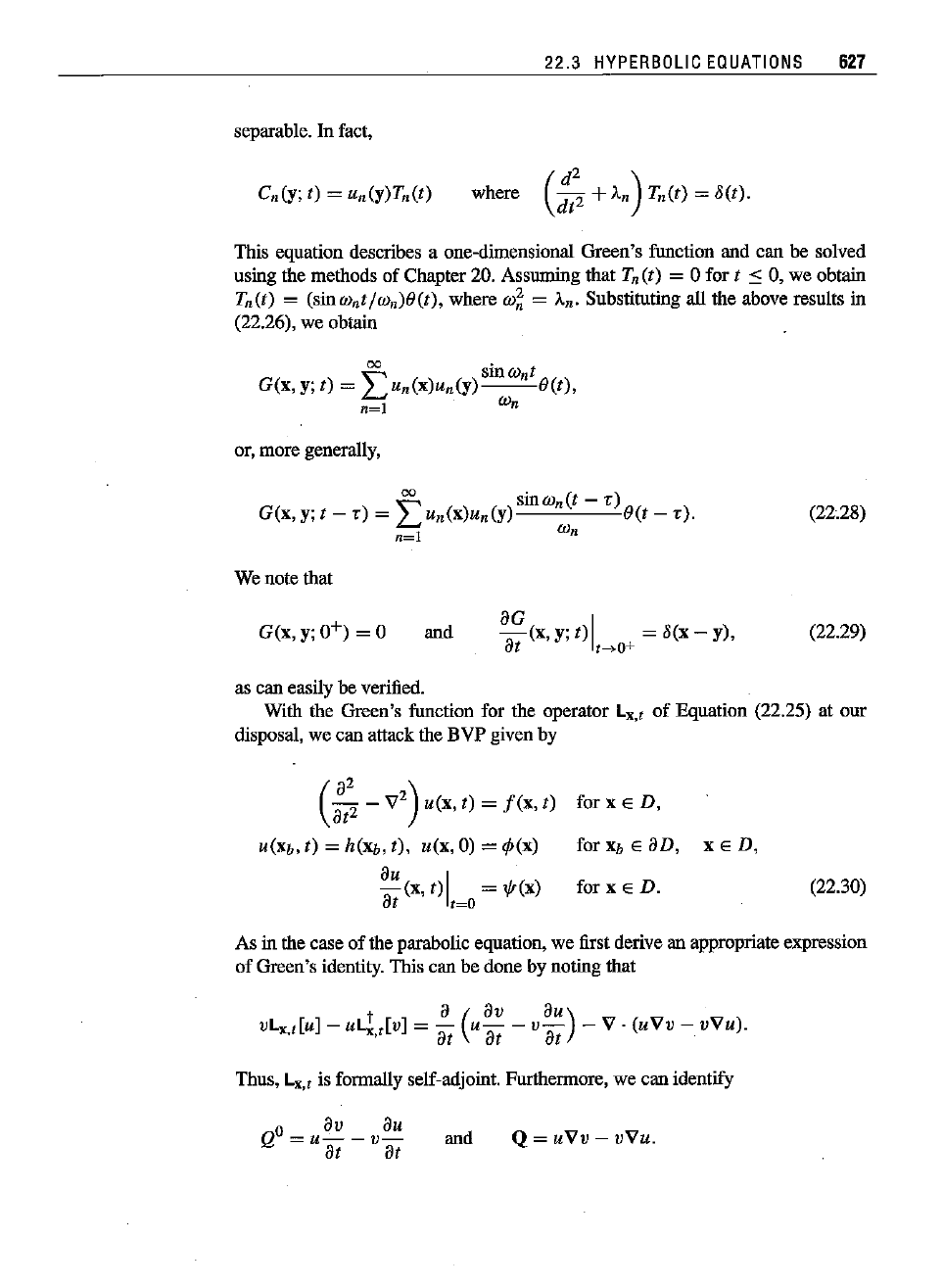
22.3
HYPERBOLIC
EQUATIONS
627
separable. In fact,
C,,(y;
t) = u,,(y)T,,(t)
where
(:t:
+
An)
Tn(t) = 8(t).
This equation describes a one-dimensional Green's function and can be solved
using the methods of Chapter 20. Assuming that
Tn(t) = 0 for t :'" 0, we obtain
T,,(t) = (sinw"t/w,,)e(t), where
w~
= An. Substituting all the above results in
(22.26), we obtain
~
sinwnt
G(x, y; t) =
L..,un(x)un(y)--O(t),
n=l
CU
n
Of,
more
generally,
~
sinwn(t -
r)
G(x, y; t -
r)
= L..,un(x)un(y) O(t -
c).
n=l
liJ
n
We note that
(2228)
G(x, y;
0+)
= 0
and
eo I
-(x,
y; t) = 8(x -
y),
at
t--).O+
(22.29)
as can easily be verified.
With the Green's function for the operator
Lx,1
of
Equation (22.25) at our
disposal, we can attack the BVP given by
(:t
22
-
'1
2
) u(x,
t)
=
!(x,
r) for
xED,
U(Xb, t) =h(Xb, r), u(x,O) =
t/J(x)
for Xb E
aD,
xED,
aa
U
(x, t) I =
1/r(x)
for
xED.
t t=O
(22.30)
As in the case of the parabolic equation, we first derive an appropriate expression
of Green's identity. This can be done by noting that
t a
(av
au)
vL flu] - U" [v] = -
u-
-
v-
- V .
(uVv
-
vVu).
x,
-X,I
at at at
Thus,
Lx,1
is formally self-adjoint. Furthermore, we can identify
o av au
Q
=u--v-
at at
and
Q=
uVv
-
vVu.
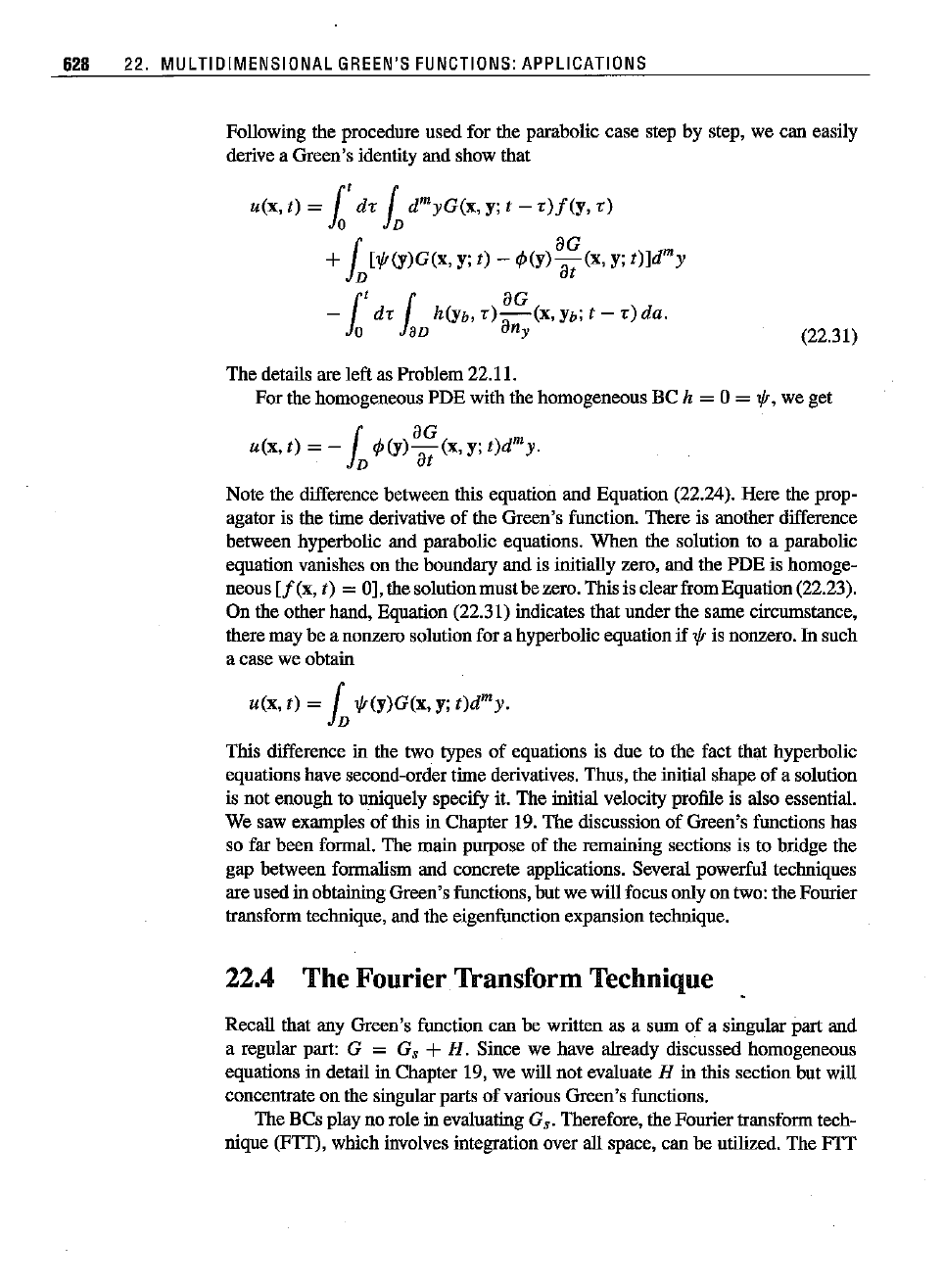
(22.31)
628 22. MULTIDIMENSIONAL
GREEN'S
FUNCTIONS:
APPLICATIONS
Following the procedure nsed for the parabolic case step by step, we can easily
derive a Green's identity and show that
u(x, t) =
fot
dt:
10
dmyG(x,
y; t -
7:)f(y,
7:)
(
aG
+1D [1ft(y)G(x, y;
t)
- </>(Y)iJt(x, Y;
t)]dmy
-r
dx
r h(Yb, 7:)
aG
(x, Yb; t -
7:)
da.
1
0
laD
any
The details are left as Problem 22.11.
For the homogeneons PDE with the homogeneous BC
h = 0 =
1ft,
we get
f
aG d
m
u(x, r) = -
</>(y)-(x,
Y;t) y.
D
at
Note the difference between this equation and Equation (22.24). Here the prop-
agator is the time derivative of the Green's function. There is another difference
between hyperbolic and parabolic equations. When the solution to a parabolic
equation vartishes on the boundary and is initially zero, and the
PDE
is homoge-
neous
[f(x,
t) = 0], the solutionmustbe zero. This is clear from Equation(22.23).
On the other hand, Equation (22.31) indicates that under the same circumstance,
there may be a nonzero solutionfor a hyperbolic equation if
1ft
is nonzero. 10such
acase we obtain
u(x, r) =
10
1ft
(y)G(x, y;
t)dmy.
This difference in the two types
of
equations is due to the fact that hyperbolic
equations have second-order time derivatives. Thus, the initial shape of a solution
is not enough to uniquely specify it. The initial velocity profile is also essential.
We saw examples
of
this in Chapter 19. The discussion of Green's functions has
so far been formal, The main purpose of the remaining sections is to bridge the
gap between founalism and concrete applications. Several powerful techniques
are used in obtainingGreen's functions, hnt we will focus only on two: the Foutier
transfoun technique, and the eigenfunction expansion technique.
22.4 The Fourier TransformTechnique
Recall that any Green's function can be written as a sum
of
a singo1ar part and
a regular part: G =
G,
+
H.
Since we have already discussed homogeneous
equations in detail in Chapter 19, we will not evaluate H in this section but will
concentrate on thesingular
parts
of
various
Green'8 functions.
The BCs play no role in evaluating
G,.
Therefore, the Foutiertransfoun tech-
nique (FTT), which involves integration over all space, can be utilized. The FTT
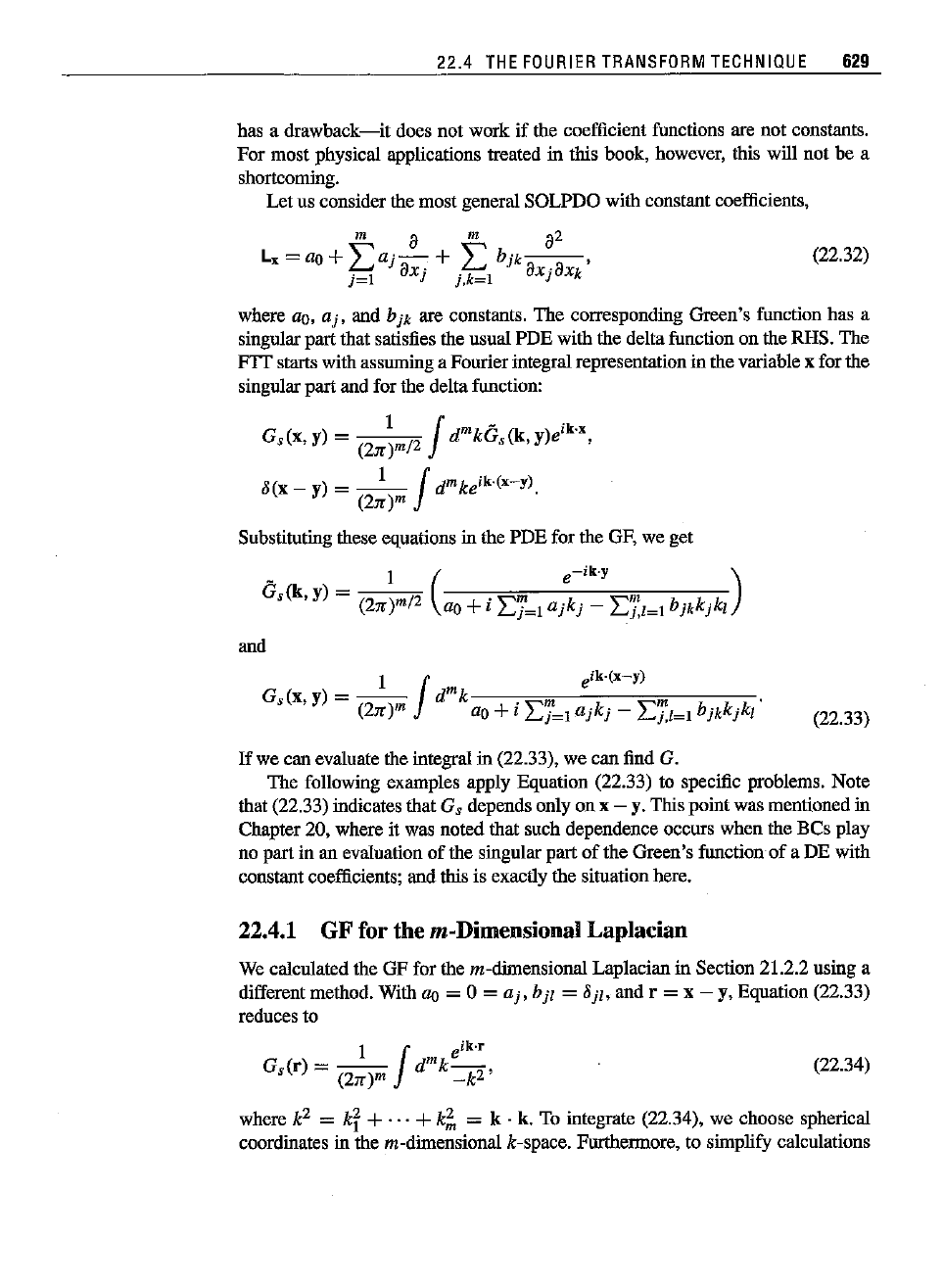
(22.32)
22.4
THE
FOURIER
TRANSFORM
TECHNIQUE
629
has a
drawback-it
does not work if the coefficient functions are not constants.
For
most physical applications treated in this book, however, this will not be a
shortcoming.
Let us consider the most general SOLPDO with constant coefficients,
m a m
a2
Lx
= ao +
~:>Fa-:
+ L
bjkaT'
)=1
XJ
j,k=l
XJ Xk
where ao,
aj,
and bjk are constants. The corresponding Green's function has a
singular partthat satisfies the usual PDE with the delta function on the RHS. The
FIT
starts with assuming a Fourier integral representation in the variable xfor the
singular part
andfor the delta function:
G,(x,y)
= I /2
jdmkG,(k,y)e
ik
'
X
,
(21f)m
8(x - y) =
_1_
jd
m
keik.(x-y).
(21f)m
Substituting these equations in the PDE for the GF, we get
and
(22.33)
(22.34)
If
we can evaluate the integral in (22.33), we
can
find G.
The following examples apply Equation (22.33) to specific problems. Note
that (22.33) indicates that
G,
depends only on x - y. This pointwas mentioned in
Chapter 20, where it was noted that such dependence occurs when the BCs play
no part in an evaluation
of
the singular part
of
the Green's function
of
a DE with
constant coefficients; and this is exactly the situation here.
22.4.1 GF for them-Dimensional Laplacian
We calculated the GF for the m-dirnensional Laplacian in Section 21.2.2 using a
different method. With
ao = 0 =
aj,
bjl = 8jz, and r = x - y, Equation (22.33)
reduces
to
I j e
ik
.•
G,(r)
= (21f)m dmk
_k2'
where k
2
= kr +...+
k~
= k . k. To integrate (22.34), we choose spherical
coordinates in the m-dirnensional k-space. Furthermore, to simplify calculations
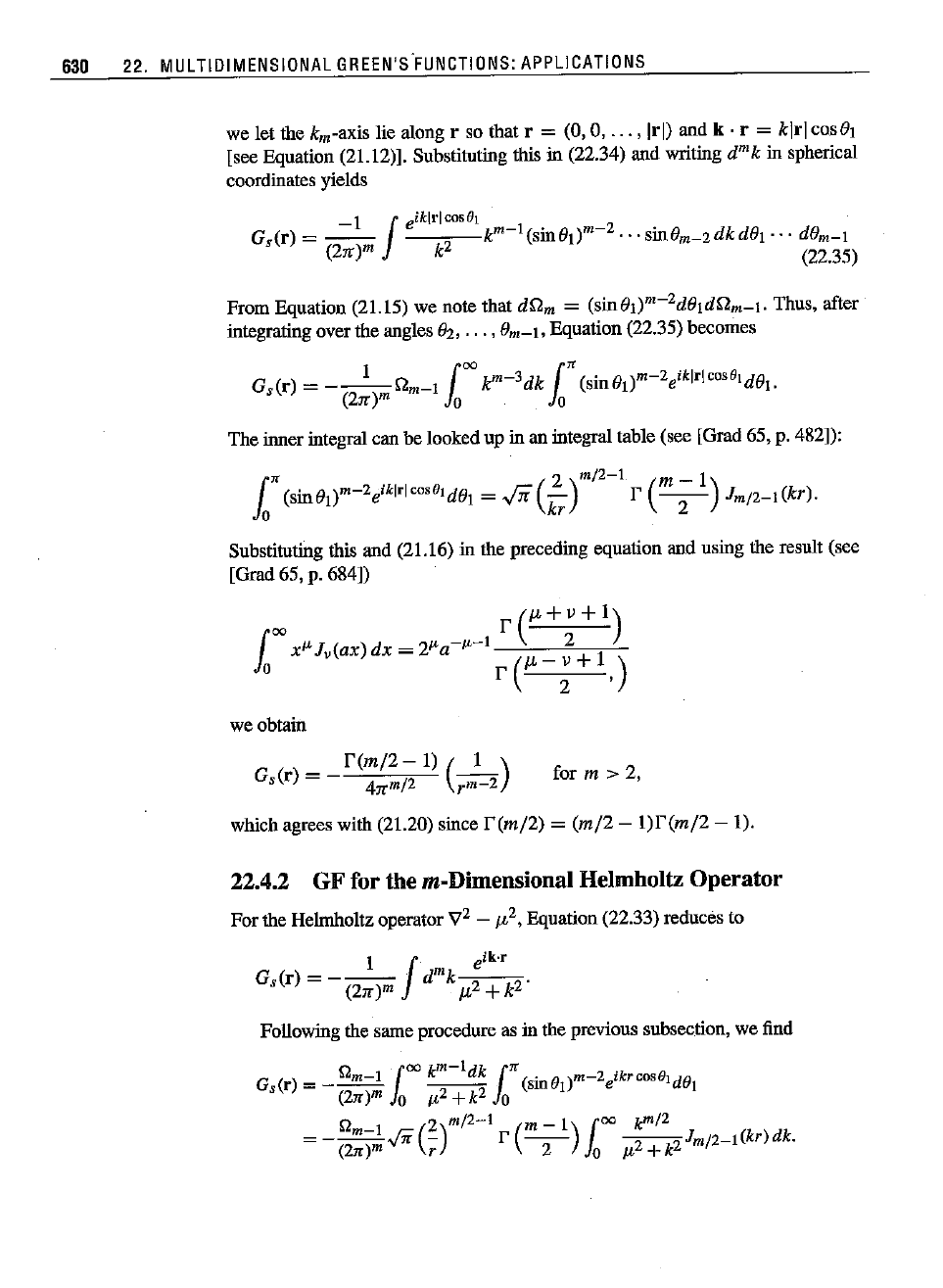
630 22.
MU
l TIDI
MENS
IONAl
GREEN'S
'FUNCTIONS:
APPll
CATIONS
we let the km-axis lie along r so that r =
(0,0,
...
, [r[) and k . r =
klrl
cos{h
[see Equation (21.12)]. Substitutiog this in (22.34) and writiog
dmk
in spherical
coordinates yields
From Equation (21.15) we note that
drl.
m
=
(sinet)m-2deldrl.m_l.
Thus, after
integrating over the angles
ez,
...
,
em-t,
Equation (22.35) becomes
G (r)
=
__
I_r1.
_
(00
k
m-
3dk
("(sine
)m-2eiklrlcoSOlde .
s (21f)m m
1
10
10
t 1
The inner integral can be looked up in an integral table (see [Grad 65, p. 482]):
r (2
)m/2-t
(m
1)
10
(sinet)m-2eiklrlcosOldel
=.fii
kr
f
--T-
J
m
/2- 1(kr).
Substitutiog this and (21.16) in the preceding equation and using the result (see
[Grad 65, p. 684])
we obtain
f(m/2
-
1)
(_1_)
4nrn/2
r
m-2
for m > 2,
which agrees with (21.20) since
f(m/2)
=
(m/2
-
1)r(m/2
- I).
22.4.2 GF for the m-Dimensional Helmholtz Operator
For the Hehnholtz operator
'17
2
-
J.t2,
Equation (22.33) reduces to
1
f'
e
ik
'
r
Gs(r)
= - (21f)m
dmk
J.t2
+k
2'
Following the same procedure as in the previous subsection, we find

22.4 THE
FOURIER
TRANSFORM
TECHNIQUE
"631
Here we can use the integral formula (see [Grad 65, pp. 686 and 952])
where
to obtain
Q
(2)m/2-1
(m
-
I)
:n:
.
G
(r)
=
-~
rrr
- r
--"
n
m/
2-
1_e,mn/4H(I)
(inr)
s (2:n:)""'" r
2""
2 m/2-1 "" ,
which simplifies to
:n:/2
(fh)m/2-1
imn/4
(I)
.
G,(r)
= -
(2:n:)m/2
-;
e H
m/
2-
1
('W)·
(22.36)
(22.37)
(22.38)
Non-local
potentials
depend
not
only
on
the
observation
point,
but
also
on
some
other
"non-local"
variables.
.
e-/l-
r
It
can be shown(see Problem22.8)that form = 3this reduces to
G,(r)
=
--4
'
:n:r
which is the Yukawa potential due to a unit charge.
We can easily obtainthe GF
for \72
+fh
2
by substituting ±ifh for
fh
in Equation
(22.36). The result is
.m+!
:n:/2
(fh)m/2-1
(I)
G,(r)
=,
/2 - H
m
/
2
1
(±W)·
(2:n:)m
r -
For m = 3 this yields
G,(r)
= _e±i/U/(4:n:r).
The
two signs in the exponent
correspondto the so-called incoming
and
outgoing "waves."
22.4.1.
Example.
Foranon-localpotential, thetime-independentSchriidingerequation
is
Then,
the
integral
equation
associated
withthis
differential
equation
is (see
Section
21.4)
\II(r) = Ae
ikor
_
---.!:!:..-
{ d
3
r, i
k1r
- r'1 ( d
3r"V(r',
r")lJ1(r").
2rr1i
2
JR'
[r -
r']
JR'
Foraseparablepotential,forwhich
V(r
',
r")
=
-g2U(r
')U(r"),
wecansolve(22.38)
exactly.
Wesubstitutefor
V(r
',
r")
in (22.38)10 obtain
(22.39)
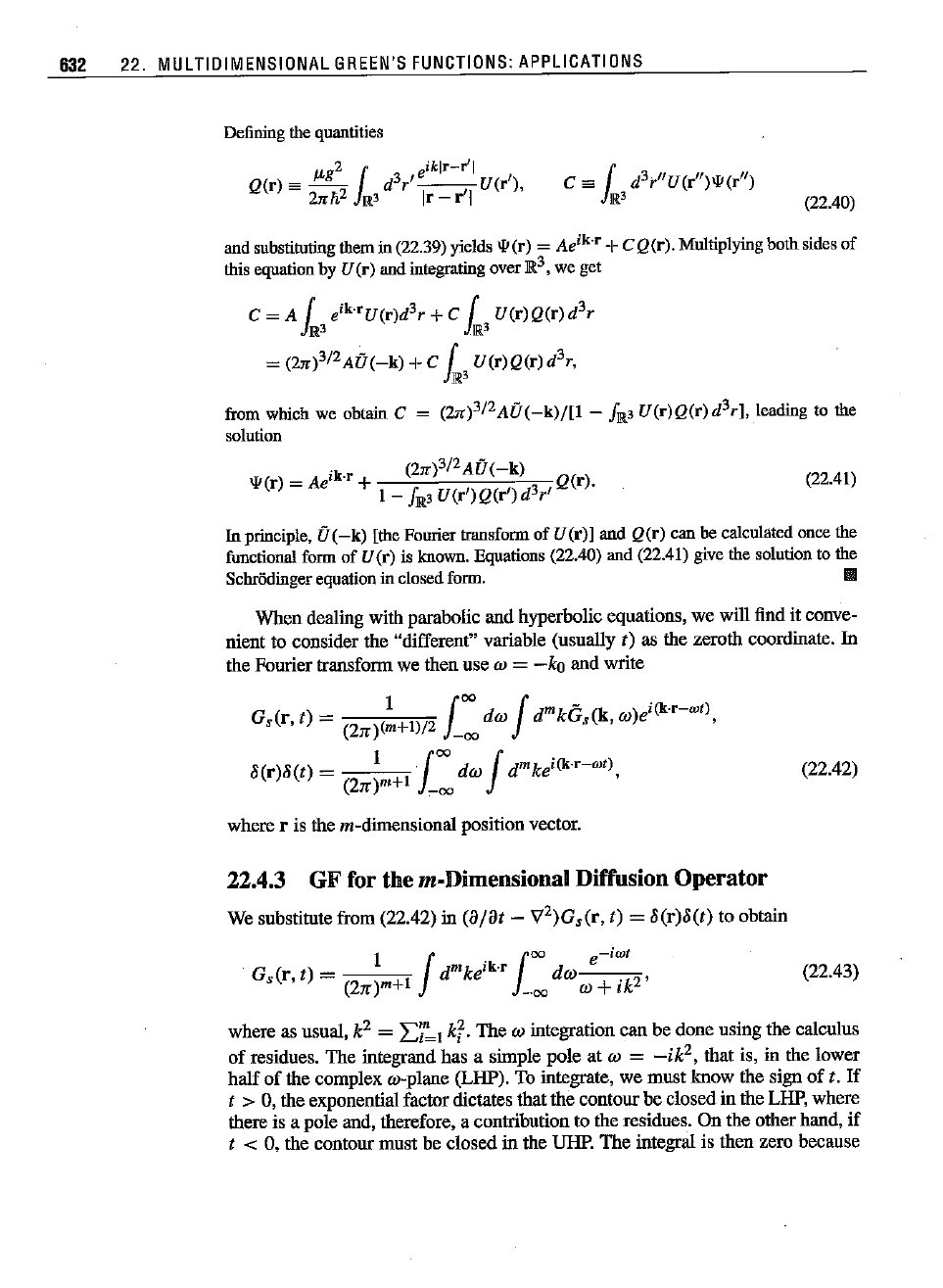
632 22. MULTIOIMENSIONAL
GREEN'S
FUNCTIONS:
APPLICATIONS
(22.40)
(22.41)
andsubstituting themin(22.39) yields'I1(r)=
Ae
ik·r
+CQ(r). Multiplyingbothsidesof
thisequationby
U(r) andintegrating over
1R
3,
we get
C = A [
e'k.rU(r)d
3r
+C [
U(r)Q(r)d
3r
JR3
J
R
3
=
(2".)3/2Ail(-k)+C
[
U(r)Q(r)d
3r,
lJW.3
from wbich we obtain C = (2Jl")3/2Ail(-k)/[1 -
JJW.3
U(r)Q(r)d
3r],
leading to the
solution
3/2 -
'I1(r)_
Ae
ik.r
+ (2".)
AU(-k)
Q(r)
-
I-JJW.3U(r
l)Q(r
l)d
3r
'·
In
ptinciple,
U(-k)
[theFouriertransform of U(r)] and Q(r) can be calculatedoncethe
functional
form of U(r) is
known.
Equations(22.40) and (22.41) givethe solutionto the
Schriidinger
equation
in closed
form.
IlII!I
Whendealing with parabolic and hyperbolic equations, we will find it conve-
nient to consider the "different" variable (usually
r) as the zeroth coordinate.
In
the Foutier transfonu we then use
co
=
-ko
and write
G
()
1 1
00
d !dmkG- (k ) i(k·r-wt)
s r, t = (m+l)J2 (J)
s,
we.
(2".)
-00
8(r)8(t)
= I
.1
00
dW!dmkeirJ<.r-wt)
(2".)m+t
-00
'
where
r is the
m-dimensional
position
vector.
22.4.3 GF for the m-Dimensional Diffusion Operator
We substitote from (22.42) in
(a/at
- V
2)G,(r,
t)
=
8(r)8(t)
to obtain
1 ! .1
00
e-
iwt
G,(r,
t) = +1
dmke,k.r
dco .
2'
(21f)m
-00
W +
ik
(22.42)
(22.43)
where as usual,
k
2
=
I:;:1
kr.
The
to integration can be done using the calculus
of
residues.
The
integrand has a simple pole at
co
=
-ik
2
,
that is, in the lower
half
of
the complex w-plane (LHP). To integrate, we must know the sign
of
t.
If
t > 0, the exponential factor dictates thatthe contour be closedin the LHP, where
there is a pole and, therefore, a contribution to the residues.
On the otherhand, if
t < 0, the contour must be closed in the UHP.
The
integral is then zero because
